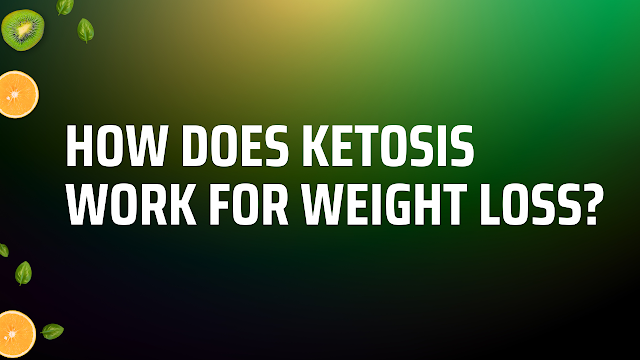Ketosis is a metabolic state where your body burns fat for energy instead of carbohydrates. It can help you lose weight, reduce your appetite, and improve your overall health. Learn how to get into ketosis and what to expect when you're there.
Understanding Ketosis for Effective Weight Management
What is Ketosis?
Ketosis is a natural metabolic state where your body changes its energy source. Instead of primarily using carbohydrates, it starts relying on stored fat for energy. This happens when your body's sugar levels drop, and the glycogen (stored sugar) gets used up.
How Does Ketosis Help with Weight Loss?
Ketosis works for weight loss through a process called ketogenesis. In this process, your body converts stored fat into molecules called ketones. Ketones become the new fuel for your body, and they're highly efficient, providing more energy for each gram compared to carbs.
Ketones also have a unique property of reducing your appetite and making you feel full. This can lead to eating fewer calories and, ultimately, weight loss.
Spotting the Early Signs of Ketosis
When your body enters ketosis, you may notice some early signs, which include:
- Increased thirst
- Frequent urination
- Foul breath
- Fatigue
- Occasional headaches
- Difficulty concentrating
What Happens When You're in Ketosis?
Being in a state of ketosis triggers several beneficial effects:
- Weight loss: Your body uses fat for energy, aiding in weight loss.
- Reduced appetite: Ketones help control hunger, potentially leading to fewer calories consumed.
- Increased energy levels: Many people report higher energy levels in ketosis.
- Improved mental clarity: Ketosis can enhance cognitive function.
- Diminished inflammation: Some individuals experience reduced inflammation while in ketosis.
Is Ketosis Good for You?
Ketosis is generally considered safe and effective for weight loss and overall health improvement. However, it may not be suitable for everyone. If you have specific medical conditions like type 1 diabetes or kidney disease, it's crucial to consult your healthcare provider before starting a ketogenic diet.
Embarking on the Journey to Ketosis
To achieve ketosis, you need to make some dietary changes:
- Reduce carbohydrate intake: In a typical ketogenic diet, carbs make up only about 5-10% of your daily calories.
- Increase healthy fats: Emphasize foods like avocados, nuts, seeds, and olive oil.
- Moderate protein intake: Include meat, fish, and eggs in your diet.
- Stay hydrated: Drinking enough water is vital.
Common Ketosis Symptoms
As you enter ketosis, you may experience some common symptoms:
- Increased thirst
- Frequent urination
- Bad breath
- Fatigue
- Occasional headaches
- Challenges with concentration
- Brain fog
- Dizziness
- Constipation
- Muscle cramps
These symptoms are typically mild and tend to fade away after a few days or weeks. If you encounter severe or concerning symptoms, consult a healthcare professional.
Is Ketosis Risky?
Ketosis is generally safe for most people. However, it can lead to side effects, as mentioned earlier. If you have underlying health conditions, particularly type 1 diabetes or kidney disease, it's wise to seek medical advice before attempting a ketogenic diet.
Exploring the Ketogenic Diet
The ketogenic diet is a low-carb, high-fat eating plan that offers various benefits, including weight loss, better blood sugar control, and a reduced risk of chronic diseases.
To follow a ketogenic diet:
- Limit carb intake: Aim for 20-50 grams of carbs per day, avoiding bread, pasta, rice, potatoes, fruit, and sugary drinks.
- Emphasize healthy fats: Include foods like avocados, nuts, seeds, and olive oil.
- Moderate protein consumption: Incorporate meat, fish, and eggs.
Commencing Ketosis: When Does It Start?
Typically, it takes around 2-4 days to enter ketosis, although the duration varies depending on your metabolism and how strictly you follow the ketogenic diet.
Ketosis in Cattle
Ketosis is a common metabolic issue in cows. It occurs when cows can't generate enough energy from sugar. This can happen if they aren't eating enough, are giving birth, or are under stress.
Ketosis in cows can lead to various problems, including weight loss, reduced milk production, and difficulty getting pregnant. In severe cases, it can result in fatalities.
Treatment Approaches for Ketosis
The treatment for ketosis depends on its underlying cause:
- If it's due to inadequate food intake, the cow should be fed a high-energy diet.
- If stress is the cause, removing the cow from the stressful situation is necessary.
- In some cases, cows with ketosis may require treatment involving fluids and electrolytes to recover fully.
Understanding these aspects of ketosis and its implications can help you make informed decisions about its role in your weight loss journey and overall health
Conclusion
Ketosis is a safe and effective way to lose weight and improve your overall health. It is important to note that ketosis is not for everyone, and people with certain medical conditions should talk to their doctor before starting a ketogenic diet.
If you are considering trying a ketogenic diet, be sure to do your research and talk to your doctor to make sure it is right for you.
FAQ
What are the benefits of ketosis?
Ketosis has been shown to have a number of benefits, including weight loss, reduced appetite, improved blood sugar control, reduced inflammation, and improved cognitive function.
How do I get into ketosis?
To get into ketosis, you need to restrict your carbohydrate intake and increase your fat intake. A typical ketogenic diet consists of 5-10% carbohydrates, 15-20% protein, and 70-80% fat.
How long does it take to get into ketosis?
It typically takes 2-4 days to get into ketosis, but it can take longer or shorter depending on your individual metabolism and how strictly you follow the ketogenic diet.
What are the symptoms of ketosis?
The early signs of ketosis can include increased thirst, frequent urination, bad breath, fatigue, headaches, and difficulty concentrating. These symptoms are usually mild and go away after a few days or weeks.
Is ketosis safe?
Ketosis is generally safe for most people. However, it is important to note that ketosis can cause some side effects, such as the ones listed above. Additionally, people with certain medical conditions, such as type 1 diabetes and kidney disease, should talk to their doctor before starting a ketogenic diet.
If you have any other questions about ketosis, please talk to your doctor or a registered dietitian.


















0 Comments